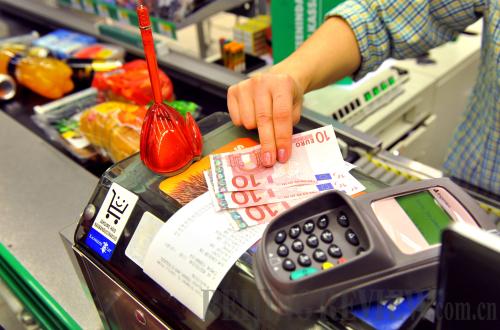|
 |
|
CURRENCY CHANGE: A checkout person gives change in euros at a supermarket in Tallinn, Estonia, on January 1, 2011 (IC) |

With the 2011 New Year's bell, Estonia joined the euro zone—a hopeful sign for the slowly recovering European economy.
The euro zone, established on January 1, 1999, now has 17 member states: Estonia, Germany, France, Italy, the Netherlands, Belgium, Luxembourg, Ireland, Greece, Spain, Portugal, Austria, Finland, Slovenia, Cyprus, Malta and Slovakia.
Successful transition
Estonia declared independence from the Soviet Union on August 20, 1991. On September 17 of the same year, Estonia joined the UN.
After independence, Estonia immediately began an economic and political transition. With the assistance of Western countries and an inherently sound economy, the transition process went smoothly.
As part of its transition, Estonia began to integrate with the European community. On March 29, 2004, Estonia joined NATO. On May 1 of the same year, it joined the EU. Then in December 2007, it joined the Schengen Agreement, which aims to eliminate border controls among its members.
But Estonia also wanted to integrate with Europe economically by joining the euro zone. Therefore, on June 28, 2004, Estonia included its currency—the kroon—in the European Exchange Rate Mechanism II (ERM II), known as the "waiting room" for adopting the euro. A country hoping to join the euro zone must participate for at least two years in the ERM II. During this period, its currency is allowed to float within a range of ±15 percent with respect to a central rate against the euro.
In addition, according to the convergence criteria of the euro zone, Estonia also had to meet certain standards in five areas—inflation, government revenues and expenditures (including public debt), exchange rates, interest rates and central bank independence. To achieve these goals, Estonia enacted various laws and requested the Central Government to maintain a balanced budget.
As a result, in comparison with other transitional countries, Estonia's financial situation is better. For example, in the second quarter of 2010, public debt as a proportion of GDP was only 6.9 percent. In addition, the inflation rate in September 2010 was only 3.1 percent.
Pros and cons
Estonia is the first former Soviet republic to join the euro zone. Inclusion in the zone is very significant for Estonia. In addition to enhancing its international status, being part of the euro zone completely ends the country's chapter as a Soviet republic and makes it a true European country.
Estonia's new status is also conducive to attracting foreign investment, since it reduces exchange rate risks as well as transaction costs associated with foreign trade. In addition, Estonia's membership can cut domestic companies' financing costs in the euro zone.
However, after joining the euro zone, Estonia will also pay a price. One disadvantage is that Estonia will no longer have an independent monetary policy, due to rules of the zone. These require that the monetary policy of euro zone member states should be formulated by the European Central Bank, while fiscal policies can be set by member states themselves. This system of a unified monetary policy and decentralized fiscal policies is considered to be an important reason for the Greek debt crisis. Therefore, the international community is curious to see what Estonia will learn from the experience of Greece.
But some analysts believe Estonia's monetary policy has actually had very little flexibility since 1992, when Estonia established a currency board. Thus, they believe the country's economy can function well even without an independent monetary policy.
|
